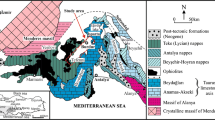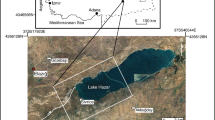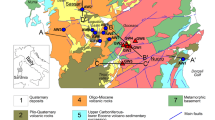Abstract
Different hot springs and boreholes in the city of Ourense, Galicia, Spain, have been studied to determine the mineral equilibrium conditions of the discharged groundwaters and the reservoir temperatures predicted by the equilibrium conditions. Ourense is located in the Miño River’s valley. The area is characterized by two fault systems, which determine groundwater circulation. A NW trending fault system is the permeable system that transfers groundwater and heat to springs in the Miño River valley as it is evident from the location of the springs in the region. Groundwaters traveling and discharging from granitic and schistose rocks are mainly bicarbonate waters. In comparison, groundwaters traveling and discharging from granodiorite rocks can be bicarbonate, sulfate or chloride waters. Different equilibrium activity diagrams for the dominant cations in groundwater (Na+, K+, Ca2+, Mg2+) have been constructed to correlate water equilibrium conditions with the mineral assemblage, K-feldspar, clinochlore, muscovite, quartz, and calcite. Granites and schists are the rocks within which groundwater circulation approaches mineral equilibrium with equilibrium temperatures around 140–160 °C. Groundwaters circulating throughout granodiorite seem a little bit high in Mg2+ to reach equilibrium conditions. Miño River’s tectonic valley presents strong morphological contrasts in terms of faulting and rock types to the north of the river that allow increased longitude and depth of groundwater circulation. These conditions allow close achievement of water–mineral equilibrium conditions. More research is needed to know the extension of this energy resource and optimize its use.








Similar content being viewed by others
References
Alves Duque MR, Monteiro Santos F, Mendez Victor LA (1998) Temperatures in the Chaves geothermal system, Northern Portugal. Geothermics 27:75–87
Araujo PA (2008) Caracterización Geológica de Surgencias Termales en la Provincia de Ourense. Ph.d. Thesys, Universidad de Vigo
Blackwell DD, Chapman DS (1977) Interpretation of geothermal gradient and heat flow data for basin and range geothermal systems. Geot Res T 1:19–20
Carreira PM, Marques JM, Carvalho MR, Capasso G, Grassa F (2010) Mantle-derived carbon in Hercynian granites. Stable isotopes signatures and C/He associations in the thermomineral waters, N-Portugal. J Volcanol Geotherm Res 189:49–56
Carreira PM, Marques JM, Carvalho MR, Nunes D, Antunes da Silva M (2014) Carbon isotopes and geochemical processes in CO2-rich cold mineral water, N-Portugal. Environ Earth Sci 71:2941–2953
Chiodini G, Marini L (1998) Hydrothermal gas equilibria: the H2O–H2–CO2–CO–CH4 system. Geochim Cosmochim Acta 62:2673–2687
Chiodini G, Cioni R, Guidi M, Marini L (1991) Chemical geo-thermometry and geobarometry in hydrothermal aqueous so- lutions: a theoretical investigation based on a mineral-solution equilibrium model. Geochim Cosmochim Acta 55:2709–2727
Chiodini G, Marini L, Russo M (2001) Geochemical evidence for the existence of high-temperature hydrothermal brines at Vesuvio volcano, Italy. Geochim Cosmochim Acta 65:2129–2147
Concello de Ourense (2012) Proyecto de Investigación do Estudo do Modelo hidrolóxico do Xacemento Termal de Ourense. Convenio de colaboración con Universidade de Vigo
Delgado-Outeiriño I, Araujo-Nespereira P, Cid-Fernandez JA, Mejuto JC, Martínez-Carballo E, Simal-Gandara J (2009) Behaviour of thermal waters through granite rocks based on residence time and inorganic pattern. J Hydrol 373:329–336
Dirección Xeral de Industria, Enerxía e Minas (2003) Cluster das augas minerais e termais de Galicia, Xunta de Galicia, Conselleria de Innovación, Industria e Comercio
Drever JI (1997) The geochemistry of natural waters: surface and groundwater environments, 3 edn. Prentice Hall, p 436
Fernández Portal JM, Corral Lledó MM, Araujo Nespereira P, Cid Fernández JA (2007) Caracterización de las aguas minerales y termales en el entorno del río Miño a su paso por la ciudad de Ourense. XII Congreso Internacional de Energía y Recursos Minerales, Oviedo
Forster C, Smith L (1988a) Groundwater flow systcms in mountainous terrain. l. Numerical modeling techniquc. Water Resour Res. 24:999–1010
Forster C, Smith L (1988b) Groundwater flow systems in mountainous terrain. 2. Controlling factors. Water Resour Res 24:1011–1023
Forster C, Smith L (1989) The influence of groundwater flow on thermal regimes in mountainous terrain: a model study. J Geophys Res 94:9439–9451
Gardien V, Rabinowicz M, Vigneresse JL, Dubois M, Boulvais P, Martini R (2016) Long-lived interaction between hydrothermal and magmatic fluids in the Soultz-sous-Forêts granitic system (Rhine Graben, France). Lithos 246–247:110–127
Giggenbach W (1984) Mass transfer in hydrothermal systems—a conceptual approach. Geochim Cosmochim Acta 48:2693–2711
Giggenbach W (1988) Geothermal solute equilibria. Derivation of Na–K–Ca–Mg geoindicators. Geochim Cosmochim Acta 52:2749–2765
Giggenbach W (1992) The composition of gases in geothermal and volcanic systems as a function of tectonic setting. In: Kharaka YK, Maest A (eds) Water–rock interaction, Balkema, Rotterdam, 7: pp 873–878
Giggenbach W (1995) Composition of fluids in geothermal systems of the Taupo Volcanic Zone, New Zealand, as a function of source magma. In: Kharaka YK, Chudaev OV (eds) Water–rock interaction, vol 8. Balkema, Rotterdam, pp 9–12
González-Barreiro C, Cancho-Grande B, Araujo-Nespereira P, Cid-Fernández JA, Simal-Gándara J (2009) Occurrence of soluble organic compounds in thermal waters by ion trap mass detection. Chemosphere 75:34–47
Haldar SK, Tišljar J (2014). Introduction to mineralogy and petrology. Elsevier, p 338
Haselwimmer C, Prakash A, Gwen Holdmann G (2013) Quantifying the heat flux and outflow rate of hot springs using airborne thermal imagery: case study from Pilgrim Hot Springs, Alaska. Remote Sens Environ 136:37–46
López DL, Smith JL (1995) Fluid flow in fault zones: analysis of the interplay of convective circulation and topographycally-driven groundwater flow. Water Resour Res 31:1489–1503
López DL, Smith JL (1996) Fluid flow in fault zones: Influence of hydraulic anisotropy and heterogeneity on the fluid flow and heat transfer regime. Water Resour Res 32:3227–3235
López DL, Smith L, Sorey ML (1994) Modeling fluid flow and heat transfer at Basin and Range faults: preliminary results for Leach Hot Springs, Nevada. Geot Res T 18:11–16
López DL, Araujo PA, Delgado I, Cid JA, Astray-Dopazo G (2015) Geochemistry of hydrothermal systems: thermal springs of Ourense. In: Proceedings in Ist International Congress on Water Healing SPA and Quality of Life, 23–26
Luecke W (1981) Lithium pegmatites in the Leinster granite (Southeast Ireland). Chem Geol 34:195–233
Marques JM, Espinha Marques J, Carreira PM, Graça RC, Aires-Barros L, Carvalho JM, Chamine HI, Borges FS (2003) Geothermal fluids circulation at Caldas do Moledo area, Northern Portugal: geochemical and isotopic signatures. Geofluids 3:189–201
Marques JM, Matias MJ, Basto MJ, Carreira PM, Aires-Barros LA, Goff FE (2010) Hydrothermal alteration of Hercynian granites, its significance to the evolution of geothermal systems in granitic rocks. Geothermics 39:152–160
Padrón E, López DL, Magaña MI, Marrero R, Pérez NM (2003) Diffuse degassing and relation to structural flow paths at Ahuachapan Geothermal Field, El Salvador. Geot Res T 27:325–330
Stumm W, Morgan JJ (1996) Aquatic chemistry: chemical equilibrium and rates in natural waters. Wiley, 3rd edn, p 1040
Acknowledgements
Authors want to acknowledge the University of Vigo, Faculty of Sciences at Ourense and Concello de Ourense for its support. G. Astray thanks to Consellería de Cultura, Educación e Ordenación Universitaria, Xunta de Galicia, for his Postdoctoral Grant (Plan I2C), POS-A/2012/164, P.P.0000 421S 140.08.
Author information
Authors and Affiliations
Corresponding author
Additional information
This article is part of a Special issue on Water Practice Issues 2015.
Rights and permissions
About this article
Cite this article
López, D.L., Araujo, P.A., Outeiriño, I.D. et al. Geochemical signatures of the groundwaters from Ourense thermal springs, Galicia, Spain. Sustain. Water Resour. Manag. 5, 103–116 (2019). https://doi.org/10.1007/s40899-018-0239-3
Received:
Accepted:
Published:
Issue Date:
DOI: https://doi.org/10.1007/s40899-018-0239-3




